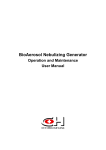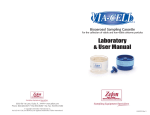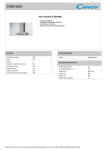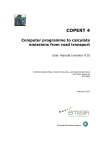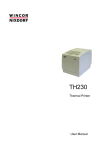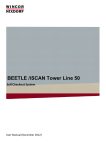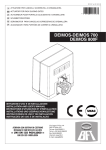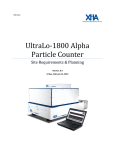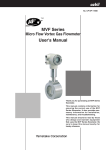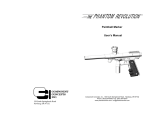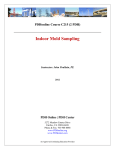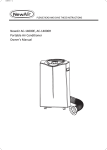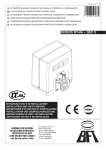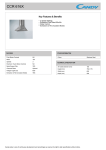Download Zefon Air-O-Cell CSI Laborotory Manual
Transcript
AIR-O-CELL® CSI Bioaerosol Sampling Cassette For the collection of viable and non-viable airborne particles Laboratory & User Manual Air-O-Cell® CSI Sampling Cassette The Air-O-Cell Collector for SEM Identification (CSI) is a unique sampling cassette specifically designed for the rapid collection and quantitative and elemental analysis of a wide range of airborne aerosols. With the Air-O-Cell CSI you can use optical and scanning electron microscopy and x-ray analysis on the exact same air sample. The Air-O-Cell CSI collects both viable and non-viable particulate such as mold spores, pollen, insect parts, skin cell fragments, fibers (asbestos, fiberglass, cellulose, etc.) and inorganic particles. Suggested & potential applications include, but are not limited to, the following: APPLICATIONS Indoor Air Quality: Mold spores, pollen, insect parts, dust mites, skin cell fragments, plant fragments, dust, fibers, combustion emissions, etc. Home Inspection: Mold contamination before or after real estate transactions. Flood Restoration: Evaluation of mold spore contamination before, during, and after remediation. Allergy Testing: Mold spores, pollen, insect parts, dust mites. Clean Room Monitoring: Evaluation of low airborne dust and contaminants from personnel (skin cells, clothing fibers, cosmetics, etc.) Fiber Analysis: Asbestos, fiberglass, cellulose, ceramics, etc. Stack Emissions: Fly ash, inorganic dust, etc. Air-O-Cell® CSI ADVANTAGES ●The sample collected in the Air-O-Cell CSI cassette can be examined and re-examined by both optical and electron microscopy in any order without significant particle loss or complex sample preparation. ●Provides excellent detection limits over conventional filter sampling utilizing 25mm or 37mm diameter filter cassettes. ●Eliminates sample loss to cassette walls known to occur with filter samples from vibration or static charge during sampling and shipment. ●Eliminates the need for direct handling or preparation of collection media or microscope slides in the field. 2 ●Eliminates potential cross-contamination between samples and during shipping that may occur with other devices. ●The high chemical stability, clarity, and ultra-smooth surface of the collection media enable a wide range of chemical, microbiological, and elemental analysis techniques. ●The unique low carbon x-ray background is specifically designed to enable the differentiation of common carbon containing indoor air quality particles (soot, rubber particles, fibers, etc.) in addition to inorganic contaminants. ●The Air-O-Cell CSI will work with virtually any kind of sampling pump capable of pulling a 15LPM (vacuum) air flow. ●The collection efficiency of the Air-O-Cell CSI cassette has proven to have stable performance at temperatures down to 0°F (depending on humidity). PRINCIPLES OF OPERATION The Air-O-Cell CSI operates on the well established principle of inertial impaction. Particles in the air stream are accelerated as they approach the tapered inlet opening and drawn through a small slit aimed directly at a glass slide. This glass slide contains a sticky and optically clear sampling media which can permanently collect and hold particles. As the particles come through the slit, the air velocity forces the particles to impact into the sampling media, while the air stream makes a sharp 90° turn and proceeds around the slide and out of the cassette. The air flow path through the Air-O-Cell CSI cassette is illustrated below in Figure 1. 3 OPERATIONAL PERFORMANCE The Air-O-Cell CSI Sampler has been evaluated in commercial and university laboratories to determine the collection efficiency and operational aspects of the collector. With impactor-type samplers, the most common measure of efficiency is defined by its “cut-point” curve. The cut-point (also referred to as the “D-50” point) is defined by the particle size at which 50% of the particles are collected and 50% pass through the sampler at a pre-determined flow rate. The ‘cut point’ for the Air-OCell CSI Sampler has been determined to be 1.56 microns at a flow rate of 15 LPM. This cut point is ideal for fungal analysis because particles smaller than this are not of interest, and may even create enough background debris to obscure adequate viewing of the sample and compromising reliable analysis. The graph below displays the collection efficiency curve for the Air-O-Cell CSI sampler when used at a flow rate of 15 LPM. AIR-O-CELL® CSI COLLECTION EFFICIENCY CURVE 100 ---90 ---- COLLECTION EFFICIENCY (%) 80 ---70 ---60 ---50 ---40 ---30 ---20 ---10 ---1 2.5 5 7.5 10 AERODYNAMIC DIAMETER (microns) RECOMMENDED SAMPLING PROCEDURES General: The Air-O-Cell CSI sampler is designed to operate at an optimal flow rate of 15 liters per minute. The user can employ any sampling pump capable of a minimum flow rate of 15 lpm. It is also capable of operating in any vertical or horizontal orientation, or in restricted access spaces smaller than 2 inches in diameter. As a result the Air-O-Cell CSI is ideally suited for sampling in HVAC ducts, plenums, wall cavities, or other confined spaces. 4 Sampling of Ambient Static Environments: A rotameter calibrated to a primary standard, soap bubble tube/meter or a dry bubble meter should be used to calibrate the sampling pump to a flow rate of 15 lpm. Some pumps only work with specific calibration devices. Please reference the owner’s manual for your pump to verify if any special calibration methods should be employed. Because the cassette does not produce significantly measurable back pressure, the rotameter can optionally be connected directly to the pump (without the Air-O-Cell CSI cassette in line) to calibrate the pump flow rate. To begin sampling, remove the tape seals covering the inlet and outlet and placed them on the side of the cassette. Then connect the Air-O-Cell CSI cassette to the sampling pump using flexible tubing. Turn the sampling pump on for an appropriate sample time ranging from 5 to 10 minutes and both seals replaced after sampling is complete. Unlike other impaction or filter sampling devices, the Air-O-Cell CSI cassette can be oriented in any vertical or horizontal direction, without concern for sample loss of large particles or vibration. “Outdoor background” samples should always be collected for comparison purposes. Sampling in HVAC Systems: The Air-O-Cell CSI cassette design allows for isokinetic sampling of aerosols in Heating, Ventilation and Air Conditioning (HVAC) Systems. Sampling can be conducted at the supply diffuser or inside most conventional ducts. The inlet of the cassette should always be facing into the flow stream. The inlet orifice has a cross-sectional area of approximately 11 mm x 15 mm (165.0 mm2) tapering to a slit with dimensions of 1.055mm x 14.5 mm (15.30 mm2). Approximate face velocity of the AirO-Cell CSI cassette is listed in Table 1. Table 1 Air Flow Velocity Guide At Orifice And Slit Face Sample Flow Rate (lpm) 15 Velocity at inlet of sample port (fpm) (mph) 299 3.4 Velocity at sample slit (fpm) (mph) 4440 50.5 Recommended Sampling Time Intervals: Although the Air-O-Cell CSI cassette can provide excellent detection limits over conventional filter sampling utilizing 25mm or 37mm diameter filter cassettes, it is also sensitive to overloading. In an appropriately loaded sample, the trace should be barely visible and transparent, but not opaque or dense. If the sample appears highly visible or opaque, additional shorter time interval samples should be collected. The recommended sampling flow rate is 15 liters per minute (lpm). Recommended sampling times (at 15 lpm) for different environmental sampling conditions are given in Table 2. 5 Table 2 RECOMMENDED SAMPLING INTERVALS Sampling Time Environmental Dust Conditions (minutes)@ 15 lpm • Outdoor sampling on a clean windless day 10 min. • “Clean” office environment or outdoors (no visible dust) 10 min. • “Indoor” environment, high activity personnel5 min. • “Indoor” environment, evidence of drywall renovation or industrial dust 1 min. • “Indoor” environment, visible dust emissions from point sources present 0.5 min. The Air-O-Cell CSI sampler is recommended to be operated in temperatures between 0°F and 120°F. At lower temperatures however, ice can accumulate inside the cassette if the relative humidity is not extremely low. After collection of the sample, the user should inspect the inside of the inlet for ice or condensation and decrease sample times to avoid ice buildup. OPTICAL EXAMINATION Optical analysis of the collected sample should be performed by an experienced Microbiologist, Aerobiologist, Mycologist or Environmental Microscopist. Slide preparation for optical examination The sealing band should be cut, and the glass cover slip (containing the sample trace) removed and placed, deposition side up, onto a glass microscope slide. A small drop of deionized or distilled water should be placed on the microscope slide and between the CSI cover slip to act as an optical coupling agent. Preparing the sample in this fashion will allow the CSI cover slip to be easily removed from the glass microscope slide after optical analysis for SEM preparation and sample analysis. (Note - Air-O-Cell CSI cassettes should only be opened in the laboratory). One to two (1-2) drops of staining or mounting media (Lacto Phenol Cotton Blue is recommended for mold spore analysis) should be placed on the center of CSI cover slip directly on the deposition trace. A 22x22mm cover slip should then be slowly placed on an angle over the drop of stain to evenly disperse the stain over the deposition area. Do not press down on the slide during or after staining! Excess staining solution should be removed from around the edges of the cover slip with a tissue wipe or cotton swab after 10 minutes has elapsed. This will ensure even staining of the sample. It should be noted that the slide can also be mounted media side up. 6 Counting and quantification of sample components is conducted by counting calibrated cross-sections of the deposited sample trace. The number and type of particles counted per cubic meter of air is calculated based on the length of the deposition trace, length of trace actually examined, volume of air collected, and number of particles counted. The Air-O-Cell CSI particle deposition area at a flow rate of 15 lpm is approximately 0.8-1.0 mm wide by 14.5mm long yielding an approximate area of 14.5mm2. The width of the deposition trace will appear to vary slightly with flow rate and the relative concentration of deposited particles. The density of particle deposition will also vary slightly from the middle to outer edges of deposition. For this reason, using the deposition trace area is not recommended for direct calculation of particle concentrations. The recommended procedure for calculating particle concentrations is based on using the Air-O-Cell CSI trace length and microscope field diameter, and will be discussed below. One field of view counted is defined as the calibrated diameter of the microscope field of view (in mm) covering one cross-sectional pass or “traverse” across the sample deposition trace. A typical sample preparation and microscopic counting procedure is illustrated in Figure 2. 7 The calculation of particle concentration per cubic meter of air can be performed by using the following equations. First, determine the actual air volume collected in cubic meters (m3) by following the calculation given in Equation 1. EQUATION 1: Air volume (m3) = (Sampling rate (liters per minute) / 1000) x Number of minutes Second, determine the length of sample trace counted based on the microscope field of view and number of fields of view counted. Accurately calibrate and measure the diameter of the microscope field of view using a stage micrometer slide. Remember, each microscope is different, and each different combination of ocular and objective lens must be calibrated separately. Stated lens magnifications are rarely precise. The microscopist should then record the number of complete traverses examined across the width of the deposition trace and use the formula given in Equation 2 to calculate the actual length of the deposition trace examined. EQUATION 2: Trace Length Counted (mm2) = Microscope field diameter (mm) x number of traverses EQUATION 3: Cts / m3 = Trace length (14.5mm) x 1 3 Total length of trace counted Air Volume (m ) (From Equation 2) (From Equation 1) 8 x # of particle counts Two example calculations for mold spores and pollen grains are given below: Example 1 Mold Spore Example Microscope field diameter at (900x) Number of traverses Sample volume (15 lpm @ 10 minutes) Mold spore counts 14.5mm 1 x 0.240 x 10 14.5 0.36 Pollen Example Microscope field diameter at (200x) Number of traverses Sample volume (15 lpm @ 30 minutes) Pollen counts 14.5mm 1 x 1.11 x 10 0.240 mm 10 (15 / 1000) x 10 = 0.150m3 50 x 50 = 2000 ct/m3 x 50 = 0.15 Example 2 = = = = 14.5 x 25 = 0.45 = = = = 1.11 mm 10 (15 / 1000) x 30 = 0.450m3 25 x 25 = 72 grains/m3 5.0 RECOMMENDED MICROSCOPIC COUNTING GUIDELINES Counting & Identification Guidelines Pollen — Entire trace or 100 grains (whichever comes first) should be examined at a minimum magnification of 200X. Identification and speciation should be performed at minimum magnification of 400X. Mold Spores — A minimum of 15% of the entire trace should be examined or a minimum of 100 mold spores counted (whichever comes first). Identification and speciation should be performed at minimum magnification of 400X. 9 Fibers — The entire trace or 100 fibers, (whichever comes first) should be examined at a minimum magnification of 200X. Other Aerosols And Opaque Particles — Skin cell fragments, combustion emissions, insect parts — A minimum of 10% of the entire trace should be examined or a minimum of 100 particles counted (whichever comes first). SEM EXAMINATION The Air-O-Cell CSI cassette can be prepared for and analyzed using Scanning Electron Microscopy (SEM). This procedure can be done on the same sample after standard optical is performed or without optical examination. If optical examination is not performed, it is not necessary to rinse the sample, however, heating of the sample is still required beginning with step 3. Specific fields identified with the optical analysis can now be re-examined and further evaluated under the SEM. Slide preparation for SEM examination Note: The adhesive needs to be fully dried, heated, and cured prior to sputter coating and Scanning Electron Microscope analysis. This procedure is required to not only prevent out-gassing into the electron microscope column, but also to prevent micro-cracking in the adhesive substrate. Throughout the following steps, take precautions to ensure the sample is not exposed to airborne laboratory contaminants. 1. Following optical analysis, carefully remove the top glass coverslip from the Air-O-Cell CSI coverslip by first applying a light rinse of deionized or distilled water, and slowly removing the 22 x 22mm coverslip. This is best performed by applying finger pressure on an angle, or blunt forceps to avoid breaking the cover slip. The stain residue should be lightly rinsed from the sample with deionized or distilled water. A second rinse with ~50% isopropyl alcohol and deionized or distilled water should be performed immediately followed by a final rinse of deionized or distilled water. 2. Remove excess water droplets with a light spray of canned air or dusting spray. 3. Place the slide on a warming plate at approximately 125°F- 150° Fforapproximately 30 minutes to dry and cure the sample. Transferthe slide to anSEM specimen mount and affix with carbon conductive paint, silver paint, or conductive carbon tabs. 4. Apply a bead of conductive carbon or silver paint from the bottom of the specimen mount to at least 2 edges and top surfaces of the CSI cover slip. This procedure is required to minimize charging in the sputter coater and electron microscope. 10 5. Sputter coat using a gold target and argon as the carrier gas. The following coating parameters are recommended: • Working distance greater than 5 cm • No more than 30mA of current • Minimum vacuum pressure of 0.08 torr. • Coat the slide in 3 increments of 15 seconds for a total of 45 seconds to reduce heating of the sample. Coating in steps will minimize heating of the sample and CSI adhesive. SEM Analysis Accelerating Voltage – Analyze the sample at an SEM accelerating voltage of 15-20kv. Note: The lower accelerating voltage provides better image and X-ray resolution of carbon and light element particles found in IAQ samples. It will also minimize sample charging and minimize cracking of the CSI collection media. All bioaerosol samplers are not created equal and will not provide the same results. All Zefon products provide you with assurance of validated, industry-proven performance and the highest quality product. Ordering Information Field Equipment Product Number Description CSI010 Air-O-Cell® CSI, 10/box AOCIW10 Inner Wall Adapter, 10/box AOCCAL In-Line Calibration Adapter 5350 SW 1st Lane, Ocala, FL 34474 • www.zefon.com Phone: 800-282-0073 • 352-854-8080 • Fax: 352-854-7480 11 5350 SW 1st Lane, Ocala, FL 34474 • www.zefon.com Phone: 800-282-0073 • 352-854-8080 • Fax: Fax: 352-854-7480 © Copyright 2006 Zefon International, Inc. LA03037 Rev 1












